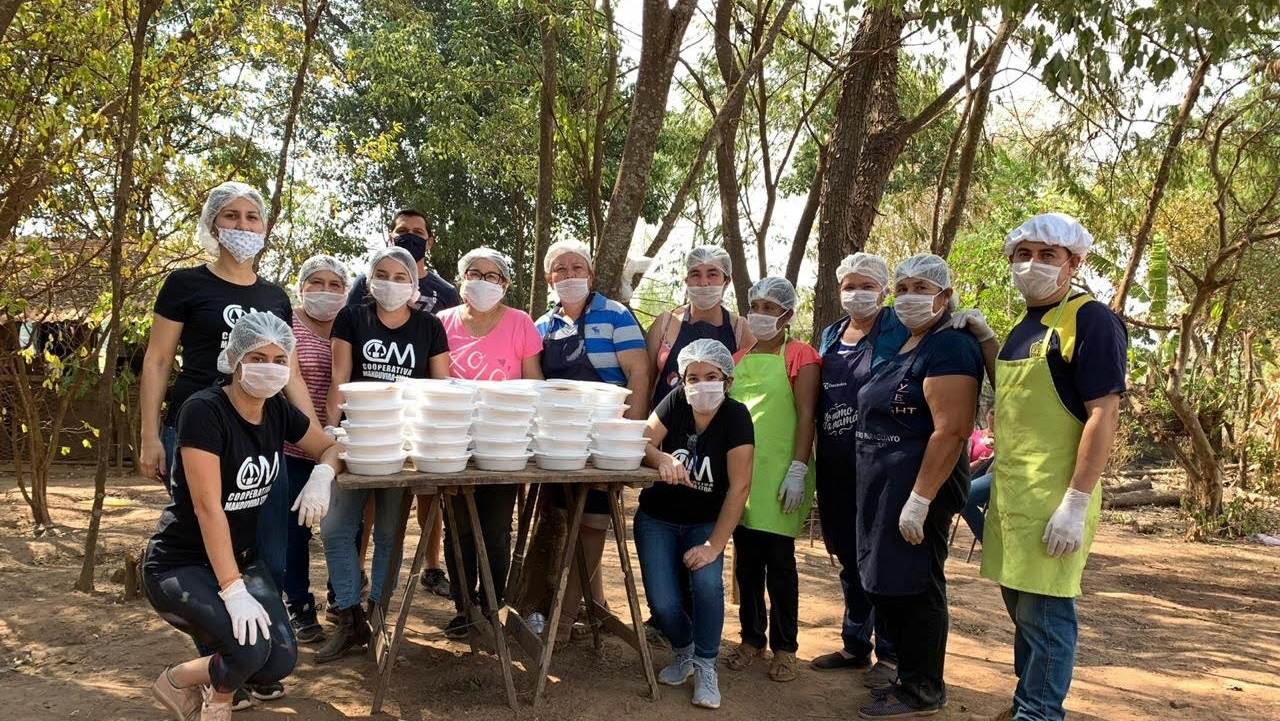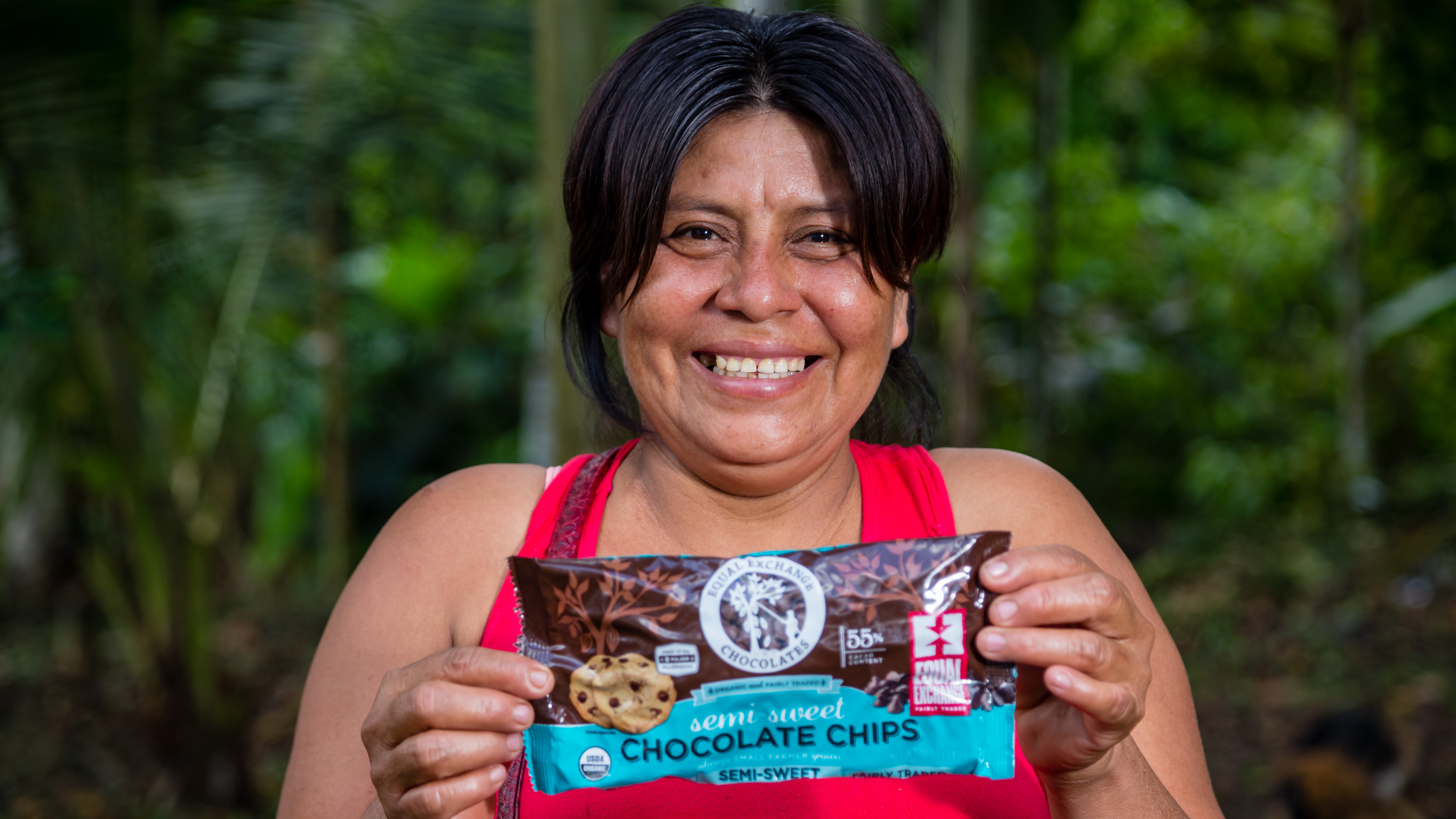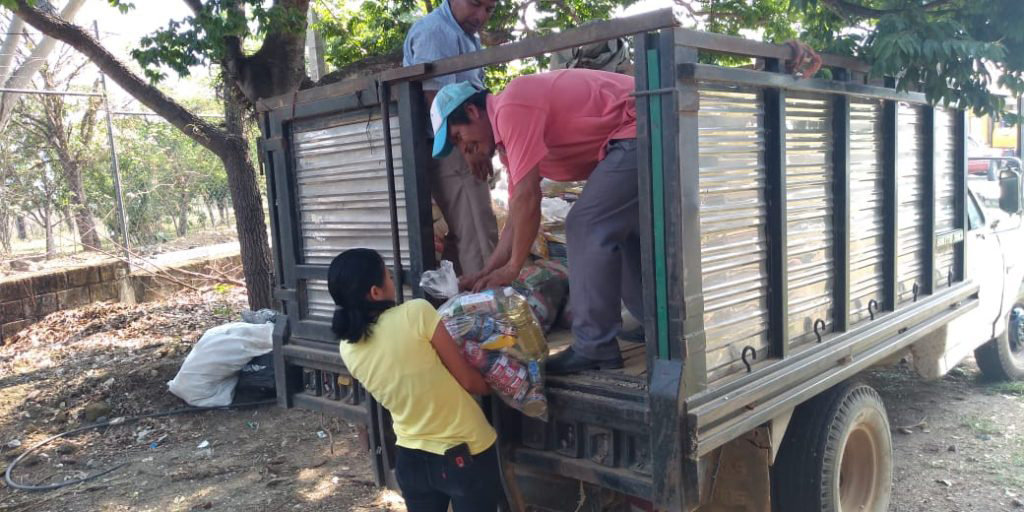This article is provided by our long-time vendor, Equal Exchange, a worker-owned co-op supporting fair trade practices among their dozens of member farm co-ops around the world.
 Manduvirá sugar co-op in Paraguay prepared and gave out 950 plates of food to vulnerable families in the community.
Manduvirá sugar co-op in Paraguay prepared and gave out 950 plates of food to vulnerable families in the community.Equal Exchange works with farmer co-ops in over 20 countries, and our model is to actively seek and partner with marginalized farming communities. These remote communities face significant challenges during the best of times. During a pandemic, the challenges become more acute. We intentionally work with farmers who have organized themselves into democratically-run cooperatives. We believe this structure helps change the balance of power long-term. We’re seeing that during the pandemic, the co-op systems have provided lifelines to farmers, helping them in ways that would not have existed were it not for the existence of the co-op.
Co-op Structures During Covid: International Connections
 Laura Bechard of Equal Exchange and Orfith Satalaya Tapullima of Oro Verde cacao co-op.
Laura Bechard of Equal Exchange and Orfith Satalaya Tapullima of Oro Verde cacao co-op.Equal Exchange has worked hard to create co-op supply chains as the core of our business. Unlike traditional trade of international goods, a large portion of our products move through a co-op supply chain: from farmer co-op at source to Equal Exchange (we are a worker-owned co-op) to about 200 food co-op stores in the U.S. (most of which are consumer-owned co-ops, with a few being hybrid models including workers and consumers).
 A selection of Equal Exchanges products.
A selection of Equal Exchanges products.As the organization in the middle of the co-op supply chain—between the farmer end and the U.S. co-op food store end—we worked hard to facilitate farmers getting information, access to financing, and timely decisions from us around purchases and contracts. For example, our long-term relationships and collaborative work on quality standards enabled us to quickly approve shipments of coffee to get containers of coffee on the water toward the U.S. to us, bypassing some of our normal protocols, securing coffee shipments before some international ports closed. We switched to digital logistics, which enabled payments to happen more quickly.
 Community members of San Fernando Co-op and Equal Exchange Worker Owners in Peru.
Community members of San Fernando Co-op and Equal Exchange Worker Owners in Peru.Due to investment over time in technology both at source and at Equal Exchange, we were able to pretty seamlessly switch more of our international work to online instead of in-person right from the start of the waves of travel bans. Some farmer groups also cited us as the most valuable early source of information regarding the coronavirus and the live-time learning that was happening about how to prevent its spread and how it was impacting workflow, transportation and our shared supply chains. Farmer co-ops had systems and field staff to help spread practical information to their often geographically-isolated member families.
Co-op Structure Impact at the Farming Community Level
 Joisy Tuanama Lumba, a member of the Huingoyacu community of ACOPAGRO, who grow the cacao in Equal Exchange chocolate chips.
Joisy Tuanama Lumba, a member of the Huingoyacu community of ACOPAGRO, who grow the cacao in Equal Exchange chocolate chips.We’ve seen many inspiring examples of how co-ops provided lifelines to their members. At the core, co-ops exist to meet the needs of their members which are not being met through more traditional systems. Over time, these co-ops have invested to build their muscles and their systems – financially, logistically, scientifically – to understand and respond to the needs of the community. They had created essential infrastructures that were already up and running, a unique strength that enabled them to respond to members’ needs during this pandemic.
Here are a few of the ways that these democratic farmer co-ops realized and responded to their members’ needs, in ways that their national governments or health care systems could not:
- Cocoa co-op Acopagro in Peru used recent advanced Fair Trade premium payments from Equal Exchange to provide food, masks and cleaning supplies to co-op members in 2 different communities where they work.
- Coffee co-op members from San Fernando in Peru focused on the fact that they had productive land at a time when many of their children were living or studying in the city without reliable access to healthy food; they collectively filled a truck with their homegrown produce and delivered the food to their children.
- Banana co-op AsoGuabo in Ecuador used Fair Trade premium funds to purchase PPE for medical workers in the community and mobilized its logistics operations to transport medicines and supplies to local hospitals. This was critical support at a time when transportation was significantly restricted as a result of curfew measures.
- Sugar Co-op Manduvira in Paraguay donated money to local health clinics, intentionally directing part of their limited resources to other trusted organizations that in turn help their members.
 Finca Triunfo Verde coffee co-op in Mexico created the Family Support Initiative to provide food to members and help them stay at home.
Finca Triunfo Verde coffee co-op in Mexico created the Family Support Initiative to provide food to members and help them stay at home.In this heavy time, there have been true moments of connection and inspiration that are important to recognize and appreciate. Out of necessity, many of us are finding new ways to listen, to share, to respond. Each co-op is engaging deeply with its membership, and as a network of co-ops, we are finding new ways to interact with each other across the supply chain. During October, we often take the time to celebrate the concept and practice of “cooperatives.”
Co-op Impact in US Communities
 An Equal Exchange cacao farmer.
An Equal Exchange cacao farmer.This work continues, as farmer co-ops, the Equal Exchange co-op, and food co-ops each and collectively continue to evolve, adapt, and keep food, income, and support flowing. As members or consumers at food co-ops in your own community, we invite you to reflect upon how it has mattered to you to be a part of your local food co-op in these times. What have you done to support your food co-op? What have they done to support their members and their communities? There is much to be grateful for. In these trying times, we all recognize that the food matters that is traded through these systems, but that the co-op systems themselves are also unique, valuable, and worthy of a spotlight.
